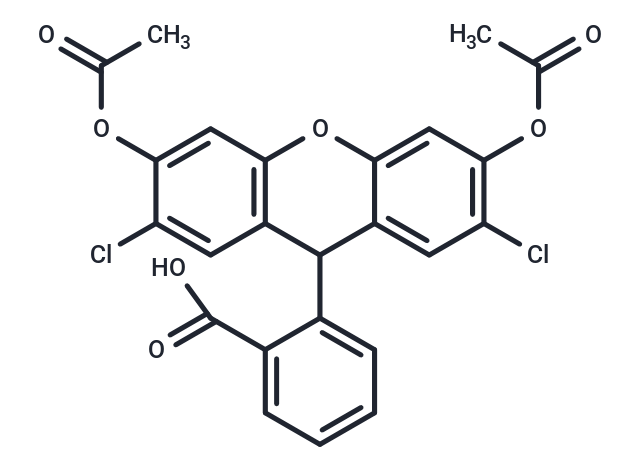Shopping Cart
- Remove All
 Your shopping cart is currently empty
Your shopping cart is currently empty

H2DCFDA (DCFH-DA) belongs to the class of green fluorescent dyes and is a probe for the detection of intracellular reactive oxygen species (ROS) (Ex/Em=488/525 nm) with cell membrane permeability.

| Pack Size | Price | Availability | Quantity |
|---|---|---|---|
| 50 mg | $37 | In Stock | |
| 100 mg | $50 | In Stock | |
| 1 mL x 10 mM (in DMSO) | $30 | In Stock |
| Description | H2DCFDA (DCFH-DA) belongs to the class of green fluorescent dyes and is a probe for the detection of intracellular reactive oxygen species (ROS) (Ex/Em=488/525 nm) with cell membrane permeability. |
| In vitro | METHODS: Flow cytometry was used to detect ROS levels: 1, H2DCFDA was dissolved into 10 mM DMSO stock solution and further diluted with PBS before use. 2. Adherent cells are incubated with 5 µM H2DCFDA solution for 30 min at 37°C, protected from light, then harvested with 0.05% trypsin-EDTA solution, suspended in fresh medium and immediately analyzed by flow cytometry (488 nm). [1] METHODS: Confocal microscopy was performed to detect ROS levels: 1. H2DCFDA was dissolved into 10 mM DMSO stock solution and further diluted with PBS before use. 2. Coverslips containing cells were placed in 5 µM H2DCFDA staining solution and incubated for 60 min at 37°C, protected from light, then washed and imaged with a confocal laser scanning microscope Leica TCS SL equipped with an argon laser. [1] |
| In vivo | METHODS: Fluorescence microscopy was used to analyze the oxidative activity of LPS induced peritonitis in mice: 1, H2DCFDA was dissolved in 100 µL ethanol and further diluted with PBS before use. 2. C57BL/6J mice were injected intraperitoneally with LPS (0.1-1 mg/mL) to induce peritonitis. 3.5 h later, H2DCFDA (0.1-0.8 mg/ml) was injected intraperitoneally. 3. 30 min after H2DCFDA injection, the animals were killed by cervical dislocation, and the peritoneal cells were recovered by rinsing with 5 mL of ice-cold HBSS solution at pH 7.4. 4. Peritoneal cells were washed and resuspended in PBS. Macrophages were removed by adhesion method after incubation in a polystyrene dish at 37℃ for 30 min. The supernatant was recovered and approximately 20,000-25,000 leukocytes were added to microscope slides using a cytocentrifuge. The slides were then analyzed using fluorescence microscopy. [2] |
| Alias | DCFH-DA, 2',7'-Dichlorodihydrofluorescein diacetate |
| Molecular Weight | 487.29 |
| Formula | C24H16Cl2O7 |
| Cas No. | 4091-99-0 |
| Smiles | CC(=O)Oc1cc2Oc3cc(OC(C)=O)c(Cl)cc3C(c2cc1Cl)c1ccccc1C(O)=O |
| Relative Density. | 1.463g/cm3 |
| Storage | keep away from direct sunlight,store at low temperature | Powder: -20°C for 3 years | In solvent: -80°C for 1 year | Shipping with blue ice. | |||||||||||||||||||||||||
| Solubility Information | Ethanol: 14.29 mg/mL (29.33 mM), Sonication is recommended. DMSO: 50 mg/mL (102.61 mM), Sonication is recommended. 10% DMSO+40% PEG300+5% Tween 80+45% Saline: 5 mg/mL (10.26 mM), In vivo: Please add the solvents sequentially, clarifying the solution as much as possible before adding the next one. Dissolve by heating and/or sonication if necessary. Working solution is recommended to be prepared and used immediately. | |||||||||||||||||||||||||
Solution Preparation Table | ||||||||||||||||||||||||||
Ethanol/DMSO
DMSO
| ||||||||||||||||||||||||||

Copyright © 2015-2025 TargetMol Chemicals Inc. All Rights Reserved.